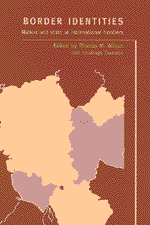Book contents
- Frontmatter
- Contents
- List of maps
- List of contributors
- Acknowledgements
- 1 Nation, state and identity at international borders
- 2 State formation and national identity in the Catalan borderlands during the eighteenth and nineteenth centuries
- 3 A western perspective on an eastern interpretation of where north meets south: Pyrenean borderland cultures
- 4 The ‘new immigration’ and the transformation of the European-African frontier
- 5 Transnationalism in California and Mexico at the end of empire
- 6 National identity on the frontier: Palestinians in the Israeli education system
- 7 Grenzregime (border regime): the Wall and its aftermath
- 8 Transcending the state? gender and borderline constructions of citizenship in Zimbabwe
- 9 Borders, boundaries, tradition and state on the Malaysian periphery
- 10 Markets, morality and modernity in north-east Turkey
- 11 Imagining ‘the South’: hybridity, heterotopias and Arabesk on the Turkish–Syrian border
- Author index
- Subject index
5 - Transnationalism in California and Mexico at the end of empire
Published online by Cambridge University Press: 02 December 2009
- Frontmatter
- Contents
- List of maps
- List of contributors
- Acknowledgements
- 1 Nation, state and identity at international borders
- 2 State formation and national identity in the Catalan borderlands during the eighteenth and nineteenth centuries
- 3 A western perspective on an eastern interpretation of where north meets south: Pyrenean borderland cultures
- 4 The ‘new immigration’ and the transformation of the European-African frontier
- 5 Transnationalism in California and Mexico at the end of empire
- 6 National identity on the frontier: Palestinians in the Israeli education system
- 7 Grenzregime (border regime): the Wall and its aftermath
- 8 Transcending the state? gender and borderline constructions of citizenship in Zimbabwe
- 9 Borders, boundaries, tradition and state on the Malaysian periphery
- 10 Markets, morality and modernity in north-east Turkey
- 11 Imagining ‘the South’: hybridity, heterotopias and Arabesk on the Turkish–Syrian border
- Author index
- Subject index
Summary
Do not ask who I am and do not ask me to remain the same: leave it to our bureaucrats and our police to see that our papers are in order. At least spare us their morality when we write.
(Foucault 1972: 17)The geopolitical wound called ‘the border’ cannot stop the cultural undercurrents. The ‘artistic border’ is artificial. It shouldn't be there, and it is up to us to erase it. (Gómez Peña 1986: 24)
This chapter has been stimulated by my ethnographic work on the US–Mexico border. My immediate problem in relation to this work is how to represent the social and cultural forms of an indigenous people – namely Mixtecs – who migrate in large and increasing numbers into this border area from their homeland in the state of Oaxaca in southern Mexico. This task of ethnographic representation is made complex not only by the spatial extension of the Mixtec community into the Border Area, but by the ambiguous nature of the Border Area itself, which has become a region where the culture, society and state of the United States encounter the Third World in a zone of contested space, capital and meanings. Furthermore, the problem of ethnographic representation of this community in this border region is made yet more problematic by a corresponding decomposition of what now, in the late twentieth century, can be seen as the ‘classic’ epistemological relationship between the anthropological Self and the ethnographic Other.
- Type
- Chapter
- Information
- Border IdentitiesNation and State at International Frontiers, pp. 117 - 141Publisher: Cambridge University PressPrint publication year: 1998
- 47
- Cited by



